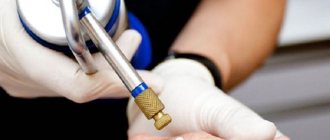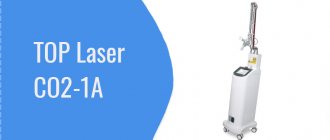The ideal for every woman is impeccably clean skin and the complete absence of all kinds of rashes, birthmarks and other defects. Modern cosmetology in Kaliningrad offers several options for removing such growths on the body, among which everyone can choose the best option for themselves.
Today, there is debate about which is better – electrocoagulation or laser. Both of these procedures are used to eliminate moles, papillomas and other defects, but they require different implementations - accordingly, each technique has individual advantages and disadvantages.
What is laser coagulation
Laser coagulation is a modern method that solves the following cosmetic problems:
- removal of unwanted hair;
- removal of tumors;
- removal of age spots, freckles;
- removal of rosacea;
- removal of stars and small vessels;
- tattoo removal.
For varicose veins, the laser scleroses the walls of blood vessels, stopping bleeding without injuring it. Laser technology is precise and painless and is used to remove the following tumors: nevi, fibromas, hemangiomas, papillomas, papillomas, warts, moles, etc. Application is possible on any part of the body.
Causes of neoplasms
One of the main reasons leading to the appearance of papillomas is HPV (human papillomavirus). In addition, the tumor may be to blame for:
- unprotected sex or indiscriminate change of sexual partners;
- disruptions in the hormonal system;
- pathologies of the digestive system;
- various pathological addictions: smoking, drugs, alcohol abuse;
- reduced immunity;
- contact with an infected person in the presence of wounds, scratches, burns, etc.;
- neglect of personal hygiene rules, etc.
In addition, an infected mother can pass the virus to her baby during natural childbirth.
It is impossible to cure HPV, it is only possible to drive it into a stage of stable remission with the help of immunomodulators and by changing your usual lifestyle.
To identify the human papillomavirus, it is necessary to donate blood for general and biochemical analysis, a biopsy from the affected area and conduct a PCR test.
Papillomas are not just a cosmetic skin defect. If the cause of the neoplasm is HPV, then in 80% of cases the skin growth is of an oncological nature. Timely diagnosis and removal have a positive prognosis.
Advantages of the methods
Advantages of laser tumor removal:
- the procedure is painless;
- not accompanied by bleeding;
- minimal risk of complications;
- short rehabilitation period.
Before carrying out the laser coagulation procedure, you must consult your doctor and become familiar with the contraindications.
After the procedure, you should not visit the sauna or bathhouse, do not take a hot bath, and you must refrain from being in the open sun. Before going outside, you should use sunscreen with an ultraviolet protection factor of SPF 50+. Electrocoagulation is carried out using a special electrocoagulator apparatus. Various new growths are cauterized without damaging the healthy tissue around them using current.
Electrocoagulation
Electrocoagulation involves touching a heated electrode to the skin and is therefore more painful than laser. Flat tumors are cauterized with a ball electrode, and convex ones are cut off with a knife - a loop. This allows analysis after the procedure. Healing of the wound takes about two weeks. Often, pits remain at the site of exposure. To avoid scars, the wound requires special care. Scarring will also occur if the mole was located in the deep layers of the skin.
Electrocoagulation is recommended for flat formations up to 10 mm in size, and for convex “pedunculated” formations. Removing moles using electrocoagulation or laser is a medical cosmetology practice and has contraindications. Therefore, before the procedure, consultation with a specialist is required.
How is the procedure performed?
After the procedure, the cauterization site heals under a dry crust, which must be treated with antiseptics for the first few days. The main advantages of electrocoagulation:
- removal of tumors;
- does not cause bleeding;
- the risk of infection is eliminated;
- does not require hospitalization;
- It is possible to carry out the procedure on all parts of the body.
Recommendations for preparing for the coagulation procedure:
- within two weeks it is necessary to avoid taking antibiotics;
- do not sunbathe in the open sun;
- Do not use products containing alcohol.
To decide to remove tumors, you need to consult a dermatologist who will select a more appropriate coagulation method.
How not to make a mistake when choosing a mole removal method?
Moles or nevi are small, usually brown formations on the skin that are found in virtually every person. They can be congenital or appear during puberty, during pregnancy, menopause, after prolonged exposure to the sun or tanning in a solarium. According to their structure, moles are divided into pigmented and vascular. Pigmented nevi include freckles, flat and raised moles; melanin pigment gives them a dark color. This substance protects our skin from ultraviolet damage. People with dark skin have more of it, and people with light skin have less. Vascular moles are formed due to abnormalities in the development of skin capillaries; they have a characteristic red color. Their shape can be very different - from a speck to a noticeably protruding nodule.
Usually nevi do not cause much concern, but in some cases there are indications for mole removal. This must be done if the mole is located on the face, spoils the appearance and causes severe psychological discomfort. Also subject to removal are moles located in places subject to mechanical damage - under the hair, on the neck, in the armpits, under the breasts, in the groin and other areas where they are rubbed by clothing or injured during a haircut or shaving. In cases where a mole begins to become inflamed, itchy, change color or increase in size, you must make an appointment with a dermatologist-oncologist. The doctor conducts an examination, prescribes a scraping, puncture or performs a dermatoscopy. This is necessary in order to promptly detect signs of degeneration of an invisible mole into a malignant melanoma tumor.
Now in St. Petersburg and other cities there are many clinics offering the removal of moles, papillomas, and warts using various methods. The most widely used methods are:
- Surgery with a scalpel;
- Cryodestruction or freezing with liquid nitrogen;
- Electrocoagulation;
- Laser mole removal;
- Radio wave surgery.
Surgical removal using a scalpel
- a simple and widespread way to get rid of a mole. Before the operation, it is necessary to undergo tests for infections transmitted through the bloodstream - HIV, syphilis, hepatitis B and C. The duration of the procedure depends on the size of the nevus and the qualifications of the doctor.
The advantages of this method are its simplicity and affordable cost. Disadvantages - pain, high trauma, the need for cosmetic stitches, and a scar may remain after removal. With this method, the removed mole is sent for histological examination. I recommend this method if there is the slightest doubt about the good quality of your mole.
Laser mole removal
– evaporation of a nevus by heating tissue up to 300 degrees Celsius with a narrowly directed laser beam of a strictly defined wavelength. Most often, this method is used to remove moles that protrude above the skin. The advantages of this method are speed of removal, low likelihood of bleeding, and relative painlessness.
The recovery period after laser mole removal takes from two weeks to a month. The duration of this period differs little from other methods. At this time, it is worth limiting your time in the sun and using special hydrophilic cosmetics. Contraindications and complications typical for laser removal are described in detail here.
Cryodestruction or removal of moles with liquid nitrogen
– with this method, the tumor is frozen to a temperature of -190ᵒC, which causes tissue death. This method is recommended for removing raised and hanging moles. At the site of the removed nevus, a crust forms, under which healthy tissue grows.
The disadvantages of this method include high trauma and a long recovery period, as well as the lack of the possibility of histological examination. During cryodestruction, it is not always possible to accurately control the depth of freezing; the procedure may need to be repeated if the tumor is not completely removed.
Electrocoagulation
– with this method, an electric current is applied to the mole, which literally burns out the tumor tissue. This is one of the most common methods of removing skin tumors. As in previous cases, a depression covered with a crust remains at the site of the tumor.
The disadvantage of this method is the high risk of scar formation and a long recovery period.
Removing moles using radio wave surgery
–
the most modern and safe method
.
As a result of directed radio wave exposure, the thinnest layer of tissue around the nevus “boils” and evaporates. The procedure itself lasts no more than 15 minutes, the mole is removed without hospitalization and the need for stitches. All removed material is sent for histological examination.
The advantages of removing moles using radio waves are minimal pain and trauma, excellent cosmetic effect, no bleeding, and rapid healing of the skin. I would also like to note that in our clinic since 2011, not a single complication has been registered after removal using the radio wave method.
We invite you to make an appointment with an experienced oncodermatologist and, if indicated, remove moles using the radio wave method using modern equipment.
Which is better to choose?
Both technologies are modern and minimally invasive, so the choice of a specific one is made according to individual indications. But in most cases, doctors recommend them like this:
- Electrocoagulation – for flat neoplasms up to 1 cm in area and for growths on legs.
- Laser – for deep flat tumors with a diameter of up to 4 cm, as well as when targeted treatment is necessary, for example, to remove spider veins or tattoos.
The latter method is still considered more progressive, if only because the average healing time for a postoperative wound is 7–10 days , whereas in the case of the classical procedure it is 10–15 days . Of course, laser correction costs at least 50% more, however, sometimes there is no alternative, for example, when the growth is covered by folds of skin and the use of a loop knife will lead to massive trauma to neighboring tissues.
Medicine and healthComment
Is it possible to get rid of blood vessels forever?
Under the influence of various aggressive factors (frequent visits to baths and saunas, excessive alcohol consumption, harsh weather conditions - extreme heat, cold, stress) - due to increased pressure in the vascular bed, neighboring vessels may begin to appear again. Unfortunately, cosmetology does not fight the cause of blood vessels, but only the aesthetic manifestations. The cause of the appearance of blood vessels on the face is identified by other specialists, and sometimes it can be very difficult to find and eliminate it. Even in this case, the vessels do not disappear on their own, and the patient in this case also turns to a cosmetologist.
Surgical removal
It is the oldest and most radical method of removing skin tumors. Preparing for the operation does not take much time. The surgical site is treated with a special antiseptic solution, after which local tissue anesthesia is performed. After anesthesia, the surgeon uses a scalpel to excise the tumor, capturing healthy tissue. This is done to remove cells that cannot be seen.
pros
- Exclusion of tumor recurrence.
- Possibility of histological examination
- Short operation time
- Does not require hospitalization; after the operation, the patient can leave the clinic.
- Depending on the location of the tumor, the “Cosmetic suture” technique is applicable.
Minuses
- Healing of the suture takes about 3-4 weeks
- Complications are possible, in the form of suppuration or swelling of the scar
- Depending on the predisposition of the skin, the formation of a keloid scar is possible.
- If care recommendations are not followed and the skin is over-tensioned, there is a risk of the seam coming apart.
Having compared the two methods, we can summarize that the laser removal technique is predominantly aesthetic in nature rather than the surgical excision technique , which helps to 100% diagnose the pathological process in the tumor and adjacent tissues. It is worth noting that the World Organization of Oncologists, as well as the recommendations of the NSSN (National Comprehensive Cancer Network), support only the surgical method of removal, as it is the safest way to get rid of skin defects caused by tumors.









